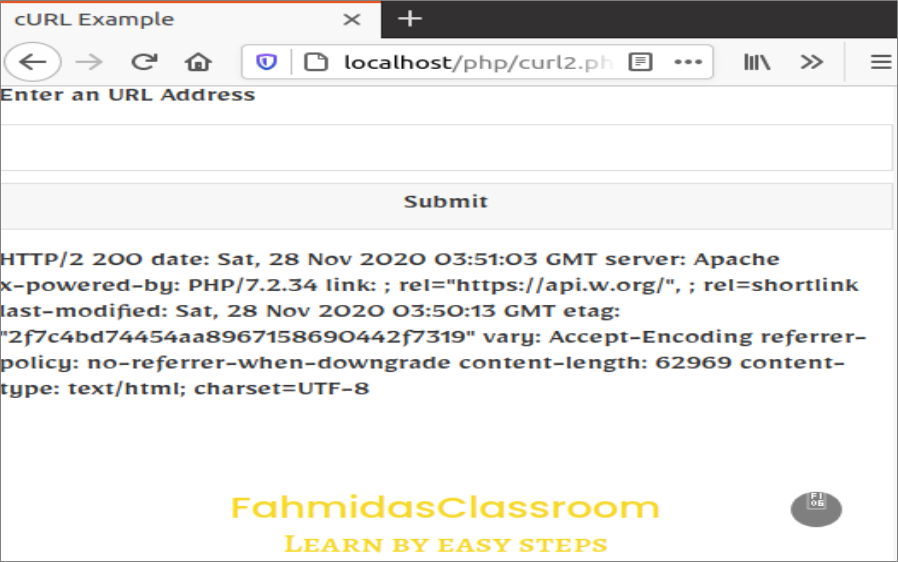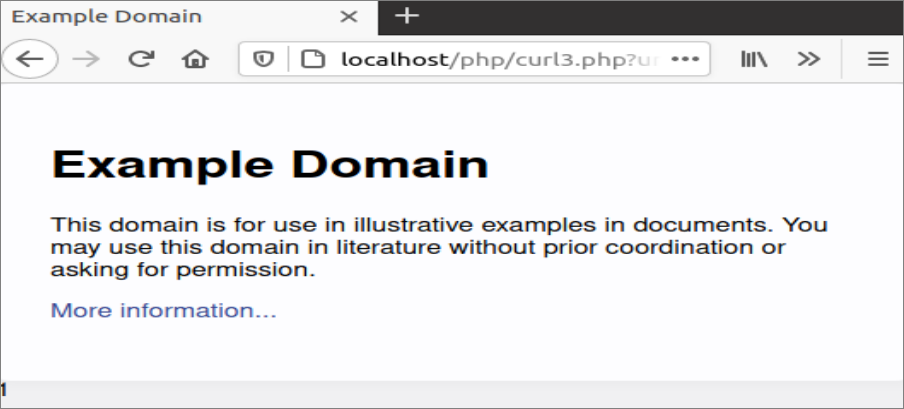PHP/cURL
The PHP module that is used to access the features of the libcurl library is called PHP/cURL. You have to check this is enabled or not in PHP before testing the examples of this tutorial. You can execute the phpinfo() function to check this module is enabled or not in PHP.
If the module is not enabled by default in PHP, then run the following commands to install and enable the php-curl on Ubuntu and restart the Apache server.
$ sudo service apache2 restart
Mostly used curl functions
| Function Name | Purpose |
|---|---|
| curl_init() | It is used to initialize a cURL session. |
| curl_exec() | It is used to executes the started cURL session. |
| curl_close() | It is used to close a cURL session. |
| curl_error() | It is used to return the last error message of the current cURL session. |
| curl_errno | It is used to return the last error number of the current cURL session. |
| curl_setopt() | It is used to set an option for a cURL transfer. |
| curl_setopt_array() | It is used to set multiple options for a cURL transfer. |
| curl_reset() | It is used to reset all options of a libcurl session. |
| curl_pause() | It is used to pause a connection. |
| curl_version() | It is used to get the information of the cURL version. |
Example 1: Retrieve the information from any URL address
Create a PHP file with the following script to retrieve the information from a particular URL address. curl_init() function is used here to initialize the cURL session for the defined URL address. The first curl_setopt() function is used to return the page content of the defined URL address. 1 is passed as the third argument value of this function to return the page content as a string value. Next, the second curl_setopt() function is used to omit the header information from the output. curl_exec() function will execute the cURL session and store the return value into $result variable that will be printed later.
//Initialize the cURL session
$ch = curl_init("https://linuxhint.com/");
//Return the page content
curl_setopt($ch, CURLOPT_RETURNTRANSFER, 1);
//Remove the header information from the output
curl_setopt($ch, CURLOPT_HEADER, 0);
//Execute the cURL session
$result = curl_exec($ch);
//Print the returned value of the website
echo $result;
//Close the cURL session
curl_close($ch);
?>
Output:
The following output will appear after running the above script. “https://ift.tt/2Wsuw9y; is given as a URL address in the script. So, the content of this site is displayed.

Example 2: Write the cURL output in a file
In the previous example, the output of the script is shown in the browser. But you can store the return value of any URL address in a file also by using cURL. Create a PHP file with the following script to take the URL address by using an HTML form and initialize the cURL session for that URL and store the page content into a text file rather than displaying it in the browser. CURLOPT_FILE option is used in curl_setopt() function to store the output after executing the cURL session into output.txt file. If the invalid URL address is submitted by the form, then the error information will be written in the file in place of the page content.
<head>
<title>cURL Example</title>
</head>
<body>
<form method="get" action="#">
<p>Enter an URL Address</p>
<p><input type="text" name="url" /></p>
<p><input type="submit" name="submit" value="Submit">
</form>
</body>
</html>
<?php
//Check the submit button is pressed or not
if(isset($_GET['url']))
{
//Check the url is empty or not
if($_GET['url'] != "")
{
//Set the URL value
$url = $_GET['url'];
//Initialize the cURL session
$ch = curl_init($url);
//Open file handler to write in a text file
$fh = fopen("output.txt", "w");
//Set option for writing the output in aa file
curl_setopt($ch, CURLOPT_FILE, $fh);
//Include header information in a file
curl_setopt($ch, CURLOPT_HEADER, 1);
//Execute the cURL session
curl_exec($ch);
//Check for any cURL error
if(curl_error($ch)) {
$error = curl_errno($ch)." : ". curl_error($ch);
fwrite($fh, $error);
}
echo "The output of the cURL session has been written in <b>output.txt</b>
file";
//Close the cURL session
curl_close($ch);
//Close the file
fclose($fh);
}
else
{
echo "No URL address is set.";
}
}
?>
Output:
The following form will be appeared after running the script. Here, a valid URL address is given as the URL address.

The following output will appear after running the pressing the submit button.

Example 3: Set cURL option using the array
If you want to set multiple cURL options at the time of executing the cURL session, then you have to use the curl_setopt_array() function. Create a PHP file with the following script to know the use of this function. Two cURL options are set using an array variable, and this variable is passed as an option variable of the curl_setopt_array() function.
//Define the array of options
$defaults = array(
CURLOPT_URL => 'http://example.com/',
CURLOPT_POST => true
);
//Initialize the cURL session
$ch = curl_init();
//Return the page content based on option array
curl_setopt_array($ch, $defaults);
//Print the returned value
echo curl_exec($ch);
?>
Output:
The following output will appear after running the script. “https://ift.tt/1tgeQSF; is given as a URL address in the script.
Conclusion
The simple uses of cURL in PHP are shown in this tutorial by using various examples. Many built-in cURL functions exist in PHP to do different types of tasks. This tutorial will help the readers to know the basic uses of cURL in PHP.
from Linux Hint https://ift.tt/3oV89Wq





0 Comments